 W
WThe Adoration of the Magi is an unfinished early painting by Italian Renaissance artist Leonardo da Vinci. Leonardo was given the commission by the Augustinian monks of San Donato in Scopeto in Florence in 1481, but he departed for Milan the following year, leaving the painting unfinished. It has been in the Uffizi Gallery in Florence since 1670.
 W
WThe Athenaeum Portrait, also known as The Athenaeum, is an unfinished painting by Gilbert Stuart of former United States President George Washington. It was created in 1796, and is considered to be Stuart's most notable work. The painting depicts Washington at age 65 on a brown background. It served as the model for the engraving that would be used for the United States one-dollar bill.
 W
WThe Bathers is an oil painting by French artist Paul Cézanne first exhibited in 1906. The painting, which is exhibited in the Philadelphia Museum of Art, is the largest of a series of Bather paintings by Cézanne; the others are in the Museum of Modern Art in New York City, National Gallery, London, the Barnes Foundation, Pennsylvania, and the Art Institute of Chicago. Occasionally referred to as the Big Bathers or Large Bathers to distinguish it from the smaller works, the painting is considered one of the masterpieces of modern art, and is often considered Cézanne's finest work.
 W
WBeata Beatrix is a painting completed in several versions by Pre-Raphaelite artist Dante Gabriel Rossetti. The painting depicts Beatrice Portinari from Dante Alighieri's 1294 poem La Vita Nuova at the moment of her death. The first version is oil on canvas completed in 1870.
 W
WCars is a series of artworks by the American artist Andy Warhol, commissioned by Mercedes-Benz in 1986.
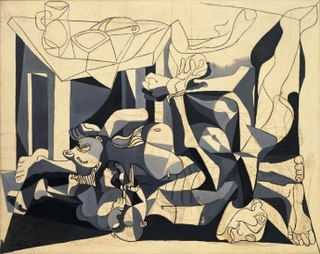 W
WThe Charnel House is a 1944–1945 oil and charcoal on canvas painting by Spanish artist Pablo Picasso, which is purported to deal with the Nazi genocide of the Holocaust. The black and white 'grisaille' composition centres on a massed pile of corpses and was based primarily upon film and photographs of a slaughtered family during the Spanish Civil War. It is considered to be Picasso's second major anti-war painting, the first being the monumental Guernica (1937), although it is smaller than its predecessor and unfinished. The painting is housed in the Museum of Modern Art in New York City.
 W
WLes Chimères or The Chimaeras is an unfinished painting by the French Symbolist painter Gustave Moreau executed in 1884. It depicts a large forest scene wherein various nude women are associated with sundry figures from classical and medieval mythology –not only the titular chimeras, but also centaurs, winged creatures, fawns, minotaurs, etc. The painting is a philosophical meditation on what Moreau saw as the elemental nature of Woman, depicting the internal yearnings and dreams of women through complex mythological symbolism. Moreau abandoned the work shortly after his mother's death to work on the darker polyptych La Vie de l'Humanité, considered one of his masterpieces.
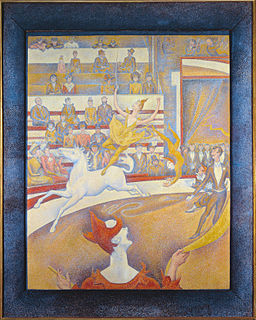 W
WThe Circus is an oil on canvas painting by Georges Seurat. It was his last painting, made in a Neo-Impressionist style in 1890–91, and remained unfinished at his death in March 1891. The painting is located at the Musée d'Orsay in Paris.
 W
WThe Conestabile Madonna is a small painting by the Italian Renaissance artist Raphael, executed c. 1502-1504. It was likely the last work painted by Raphael in Umbria before moving to Florence.
 W
WCongress Voting Independence is a painting by Robert Edge Pine showing the interior of Independence Hall, Philadelphia, and contains the portraits of most of the signers of the United States Declaration of Independence. The artist worked on the painting from 1784 until his death in 1788. The painting is unfinished. It currently is held in Independence Hall, Philadelphia.
 W
WCross at Sunset is an oil on canvas painting by Thomas Cole. Believed to have been created around 1848, it was left unfinished due to his premature death that year.
 W
WThe Death of Actaeon is a late work by the Italian Renaissance painter Titian, painted in oil on canvas from about 1559 to his death in 1576 and now in the National Gallery in London. It is very probably one of the two paintings the artist stated he had started and hopes to finish in a letter to their commissioner Philip II of Spain during June 1559. However, most of Titian's work on this painting possibly dates to the late 1560s, but with touches from the 1570s. Titian seems never to have resolved it to his satisfaction, and the painting apparently remained in his studio until his death in 1576. There has been considerable debate as to whether it is finished or not, as with other very late Titians, such as the Flaying of Marsyas, which unlike this has a signature, perhaps an indication of completion.
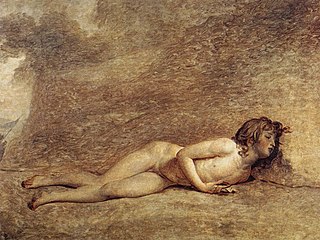 W
WThe Death of Young Bara, Joseph Bara or The Death of Bara is an incomplete 1794 painting by the French artist Jacques-Louis David, now in the musée Calvet in Avignon. Joseph Bara, a young drummer in the army of the French First Republic, was killed by the Vendéens. He became a hero and martyr of the French Revolution and – with The Death of Marat and The Last Moments of Michel Lepeletier – the painting formed part of a series by David showing such martyrs. There is also an anonymous contemporary copy dating to 1794, now in the Palais des Beaux-Arts de Lille and exhibited at the Musée de la Révolution française.
 W
WLe Déjeuner sur l'herbe is an 1865–1866 oil on canvas painting by Claude Monet, produced in response to the 1863 work of the same title by Édouard Manet. It remained unfinished, but two large fragments are now in the Musée d'Orsay in Paris, whilst a smaller 1866–1867 version is now in the Pushkin Museum in Moscow.
 W
WDeposition of Christ, also known as Descent from the Cross, is a painting from approximately 1491 by Benozzo Gozzoli. Among Gozzoli's last works, it was still unfinished in his studio by the time of his death. Years later his heirs sold it to the Diocese of Pistoia. It then passed to the Sozzifanti family, from whom it was later inherited by Charles Borbone, Duke of Lucca. It was bought by Herbert Horne in 1907 and now in the Museo Horne in Florence. It was restored in 1990.
 W
WThe Dream of Ossian is an 1813 painting by the French artist Jean-Auguste-Dominique Ingres. The work depicts the legendary poet Ossian sleeping while he dreams of relatives, warriors, and maidens, which appear above him on the canvas. Ingres was influenced by his contemporaries' Ossianic works, including James Macpherson's purported translations of Ossian's poems, François Gérard's 1801 painting Ossian Evoking Phantoms, and Jean-François Le Sueur's 1803 opera Ossian, ou Les bardes.
 W
WThe Entombment is an unfinished oil-on-panel painting of the burial of Jesus, now generally attributed to the Italian Renaissance master Michelangelo Buonarroti and dated to around 1500 or 1501. It is in the National Gallery in London, which purchased the work in 1868 from Robert Macpherson, a Scottish photographer resident in Rome, who, according to various conflicting accounts, had acquired the painting there some 20 years earlier. It is one of a handful of paintings attributed to Michelangelo, alongside the Manchester Madonna, the Doni Tondo, and possibly The Torment of Saint Anthony.
 W
WThe Fairy Feller's Master-Stroke is a painting by English artist Richard Dadd. It was begun in 1855 and worked on until 1864. Dadd painted it while incarcerated in the State Criminal Lunatic Asylum of Bethlem Royal Hospital, where he was confined after he murdered his father in 1843. It was commissioned by George Henry Haydon, who was head steward at the hospital at the time.
 W
WFarms near Auvers or Thatched Cottages by a Hill is an oil painting by Vincent van Gogh that he painted in July 1890 when he lived in Auvers-sur-Oise, France. The painting is an example of the double-square canvases that he employed in his last landscapes.
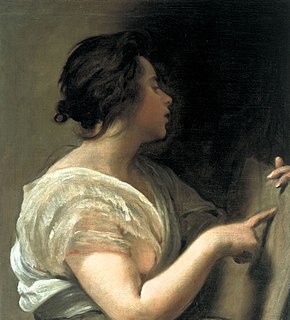 W
WFemale Figure is a small, probably unfinished, 1648 oil on canvas painting by Diego Rodríguez de Silva y Velázquez, the leading artist of the Spanish Golden Age. Although the identity of the woman is unknown, she is usually believed to be a sibyl, based on her similarity to the artist's 1631–32 Sibyl . Both show profile views of women in half length, holding a tablet. The c. 1648 date is given based on its stylistic resemblances to the artist's Rokeby Venus. Both works share the evocative, loose and fluid brush strokes generally accepted as influenced by Velázquez's exposure to Titian during his 1629–30 and 1649–51 visits to Italy. Female Figure is noted for its "restrained elegance, muted color harmonies, and the evocative poetry of the figure's parted lips and "lost" profile."
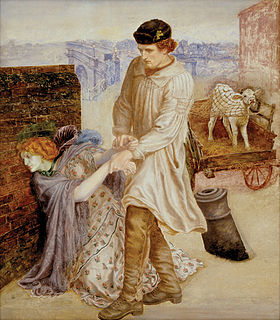 W
WFound is an unfinished oil painting by Dante Gabriel Rossetti, now in the Delaware Art Museum. The painting is Rossetti's only treatment in oil of a contemporary moral subject, urban prostitution, and although the work remained incomplete at Rossetti's death in 1882, he always considered it one of his most important works, returning to it many times from the mid-1850s until the year before his death.
 W
WThe Funeral is an 1867–1870 oil on canvas painting by Édouard Manet, now in the Metropolitan Museum of Art in New York. Incomplete, its style is very close to that of Effect of Snow on Petit-Montrouge and The Exposition Universelle of 1867. It is also known as Burial at the Glacière, the title given to it in Denis Rouart and Daniel Wildenstein's posthumous inventory of Manet's works.
 W
WHoly Family with the Infant Saint John the Baptist is an unfinished c.1521 oil on panel painting by Rosso Fiorentino, produced early in his stay in Volterra. The work is now in the Walters Art Museum in Baltimore.
 W
WThe Judgement of Solomon is an oil on canvas painting by Sebastiano del Piombo of the Judgement of Solomon, executed c. 1505–1510, now in the Bankes collection at Kingston Lacy, a National Trust property in Dorset, England.
 W
WThe Madonna with the Long Neck, also known as Madonna and Long Child with Angels and St. Jerome, is an Italian Mannerist oil painting by Parmigianino, dating from c. 1535-1540 and depicting Madonna and Child with angels. The painting was begun in 1534 for the funerary chapel of Francesco Tagliaferri in Parma, but remained incomplete on Parmigianino's death in 1540. Ferdinando de' Medici, Grand Prince of Tuscany, purchased it in 1698 and it has been on display at the Uffizi since 1948.
 W
WThe Madonna and Child with St John and Angels (c. 1497), also known as The Manchester Madonna, is an unfinished painting attributed to Michelangelo in the National Gallery, London. It is one of three surviving panel paintings attributed to the artist and is dated to his first period in Rome. The painting's attribution to Michelangelo was in doubt for much of the 19th and 20th centuries, but now most scholars are in agreement. The work first came to public attention in the Art Treasures Exhibition in Manchester in 1857, hence the title the “Manchester Madonna”.
 W
WMystic Marriage of Saint Catherine is an unfinished c.1529 oil on panel painting of the mystical marriage of Saint Catherine by Parmigianino.
 W
WThe Needlewoman is an oil-on-canvas painting by Diego Velázquez, painted between 1635 and 1643. It is housed in the National Gallery of Art in Washington, D.C.
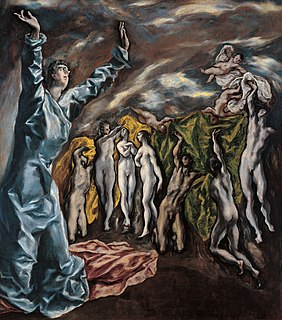 W
WThe Opening of the Fifth Seal was painted in the last years of El Greco's life for a side-altar of the church of Saint John the Baptist outside the walls of Toledo. Before 1908, El Greco's painting had been referred to as Profane Love. The scholar Manuel B. Cossio had doubts about the title and suggested the Opening of the Fifth Seal. The Metropolitan Museum, where the painting is kept, comments: "the picture is unfinished and much damaged and abraded."
 W
WThe Polish Rider is a seventeenth-century painting, usually dated to the 1650s, of a young man traveling on horseback through a murky landscape, now in The Frick Collection in New York. When the painting was sold by Zdzisław Tarnowski to Henry Frick in 1910, there was consensus that the work was by the Dutch painter Rembrandt. This attribution has since been contested, though those who contest it remain in the minority.
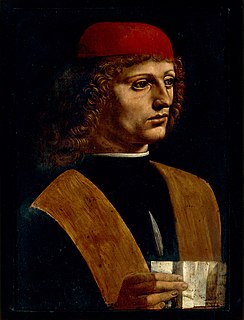 W
WThe Portrait of a Musician is an unfinished painting widely attributed to the Italian Renaissance artist Leonardo da Vinci, dated to c. 1483–1487. Produced while Leonardo was in Milan, the work is painted in oils, and perhaps tempera, on a small panel of walnut wood. It is his only known male portrait painting, and the identity of its sitter has been closely debated among scholars.
 W
WPortrait of Ambroise Vollard is an 1899 oil-on-canvas portrait by Paul Cézanne of his art dealer Ambroise Vollard. It was bequeathed by Vollard on his death to the Petit Palais in Paris, where it is still housed today. Like many of his portraits, the Portrait of Ambroise Vollard displays the significant role of the subject in Cézanne's life, and specifically, the artist's gratitude for promoting his work and establishing his reputation as an artist.
 W
WThe Portrait of Frédéric Chopin and George Sand was an 1838 unfinished oil-on-canvas painting by French artist Eugène Delacroix. Originally a double portrait, it was later cut in two and sold off as separate pieces. It showed composer Frédéric Chopin (1810–49) playing the piano while writer George Sand (1804–76) sits to his right, listening and sewing. The sitters were lovers at the time, and both were close friends of the artist.
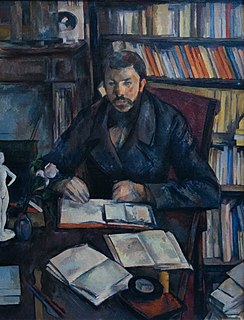 W
WPortrait of Gustave Geffroy is a c. 1895 painting by the French Post-Impressionist artist Paul Cézanne. It portrays Gustave Geffroy, a French novelist and art critic noted as one of the earliest historians of Impressionism.
 W
WThe Portrait of Juan Martínez Montañés is an unfinished 1636 portrait of the sculptor Juan Martínez Montañés by Diego Velázquez. It is now in the collection of the Prado museum in Madrid.
 W
WThe Portrait of Madame Marie-Louise Trudaine is an unfinished 1791–1792 portrait of Marie-Louise Trudaine by the French painter Jacques-Louis David. It was commissioned from David by her brothers-in-law, the Trudaine brothers who welcomed David, the poet André Chénier, and other major artists of the time to their Parisian salon at place des Vosges. It shows her seated on a simple chaise, with her hands crossed on her lap and wearing a sober dress, a blue waist-sash and a white collar. Her expression is worried and reinforced by the tormented background and her unkempt hair.
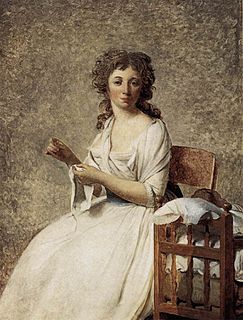 W
WPortrait of Madame Pastoret is a 1791 portrait by Jacques-Louis David. It shows Adélaide Pastoret, née Piscatory de Vaufreland (1765-1843). He was a friend of the Pastoret family but broke with them in 1792 after he became more politically radical. With his portraits of Philippe-Laurent de Joubert and Madame Trudaine, it was one of three paintings left incomplete due to the advance of the French Revolution - all three figures were arrested or emigrated. An infant's head is also shown in the cot - this is Amédée de Pastoret, a future conseiller d'Etat, painted by Ingres in 1826.
 W
WPortrait of Philippe-Laurent de Joubert is a painting by Jacques-Louis David. Its date is unknown, but Antoine Schnapper argues that it was between 1790 and 1792, since the subject died on 30 March 1792. It was left incomplete like his portraits of Madame Trudaine and Madame Pastoret. It is now in the Musée Fabre in Montpellier.
 W
WPortrait of the Artist's Family is a 1558–59 oil on canvas painting by the Italian artist Sofonisba Anguissola in the Nivaagaard art gallery.
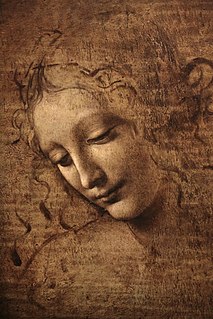 W
WLa Scapigliata is an unfinished painting generally attributed to the Italian High Renaissance artist Leonardo da Vinci, and dated c. 1506–8. Painted in oil, umber and white lead pigments on a small poplar wood panel, its attribution remains controversial, with several experts attributing the work to a student of Leonardo. The painting has been admired for its captivating beauty, mysterious demeanor, and mastery of sfumato.
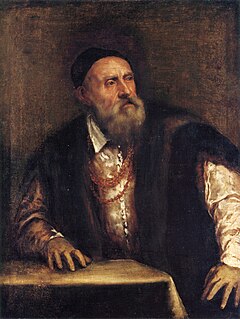 W
WSelf-Portrait is an oil on canvas self-portrait by the Venetian painter Titian, dated c. 1546–47. While he painted a number of independent self-portraits in various formats, this is one of only two painted examples to survive. The other is in Madrid, dated c. 1560. Both share a somber and reserved pallet, although this example is richer in tonal variation and colour harmonisation.
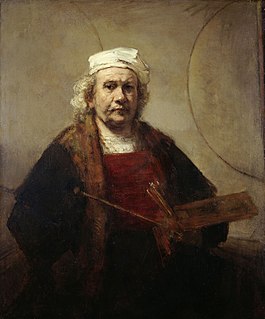 W
WSelf-Portrait with Two Circles is an oil on canvas painting by the Dutch artist Rembrandt, painted c. 1665–1669, one of over 40 painted self-portraits by Rembrandt.
 W
WSt Francis is an undated and unfinished oil on canvas painting attributed to Bernardo Strozzi. It is housed in the parish church in Campagnola Cremasca.
 W
WSaint Jerome in the Wilderness is an unfinished painting by Italian Renaissance artist Leonardo da Vinci, dated c. 1480–1490. The composition of the painting has been drafted in monochrome onto the primed wooden panel. At an unknown date after Leonardo's death, the panel was cut into five pieces before eventually being restored into its original form. Created during Leonardo's last years in Florence, or first years in Milan, the work is now in the Vatican Museums.
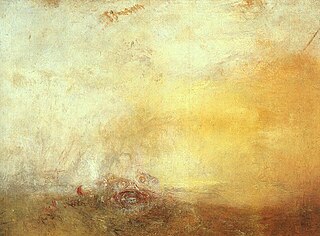 W
WSunrise with Sea Monsters is an unfinished oil painting by English artist J. M. W. Turner.
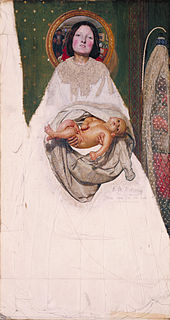 W
WTake Your Son, Sir! (1851–56) is an unfinished painting by Ford Madox Brown which depicts a woman showing her newborn son to its father. She is offering her baby towards the viewer of the painting, who is implicitly equated with the father - seen in the mirror behind, opening his arms to receive the baby. The mirror also forms a halo behind the mother's head, and the pattern on the wallpaper suggests the starry heavens. Brown's principal influence was Jan van Eyck's painting the Arnolfini Marriage Portrait, recently acquired by the National Gallery. The mirror resembles the circular mirror in van Eyck's painting, which reflects an image of the artist looking at the couple in the image.
 W
WThe Tennis Court Oath is an incomplete painting by Jacques-Louis David, painted between 1790 and 1794 and showing the titular Tennis Court Oath at Versailles, one of the foundational events of the French Revolution.
 W
WThe French painter Honoré Daumier made at least three oil paintings entitled The Third-Class Carriage. In a realistic manner, Daumier depicts the poverty and fortitude of working class travellers in a third class railway carriage. One oil-on canvas version, dated to c. 1862–1864 but left unfinished, is in the collection of the Metropolitan Museum of Art in New York City, and a similar but completed painting dated to c. 1863–1865 is in the National Gallery of Canada. A third oil-on-panel version, dated to c. 1856–1858, with a different arrangement of the main three figures, is held by the Fine Arts Museums of San Francisco.
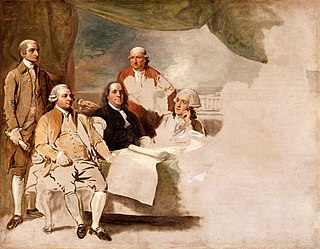 W
WAmerican Commissioners of the Preliminary Peace Agreement with Great Britain, also known as the Treaty of Paris, is a 1783 painting by Benjamin West depicting the United States delegation preparing to further negotiate and sign the 1783 Treaty of Paris and formally end the American Revolutionary War. The eventual signing of the treaty took place on 3 September 1783 at the Hotel York at 56 rue Jacob.
 W
WThe unfinished portrait of Franklin D. Roosevelt is a watercolor of Franklin Delano Roosevelt, President of the United States, by Elizabeth Shoumatoff. Shoumatoff was commissioned to paint a portrait of President Roosevelt and started her work around noon on April 12, 1945. At lunch, Roosevelt complained of a headache and subsequently collapsed. The president, who had suffered a cerebral hemorrhage (stroke), died later that day.
 W
WVictory Boogie Woogie is the last, unfinished work of the Dutch abstract painter Piet Mondrian. Left incomplete in 1944, since 1998 it has been in the collection of the Kunstmuseum in The Hague. It was purchased at a cost of 80 million Dutch guilders from the American collector Samuel Irving Newhouse, who purchased the work from Emily and Burton Tremaine for US$12 million in the mid 1980s. It was bought by the Stichting Nationaal Fonds Kunstbezit through a gift from the Dutch Central Bank, commemorating the introduction of the euro. This amount of money spent on the gift raised questions in the Dutch House of Representatives.
 W
WThe Virgin and Child with Saint Anne is an unfinished oil painting of c. 1503 by Italian Renaissance artist Leonardo da Vinci depicting Saint Anne, her daughter the Virgin Mary and the infant Jesus. Christ is shown grappling with a sacrificial lamb symbolizing his Passion as the Virgin tries to restrain him. The painting was commissioned as the high altarpiece for the Church of Santissima Annunziata in Florence and its theme had long preoccupied Leonardo.
 W
WWar is the title of two oil paintings on the same theme completed in quick succession in 1896 by the Swiss Symbolist painter Arnold Böcklin. The first version is in the collection of the Galerie Neue Meister, Dresden and the second, defined as unfinished, in the Kunsthaus Zürich in Switzerland.
 W
WThe West Wind is a 1917 painting by Canadian artist Tom Thomson. An iconic image, the pine at its centre has been described as growing "in the national ethos as our one and only tree in a country of trees". It was painted in the last year of Thomson's life and was one of his final works on canvas.
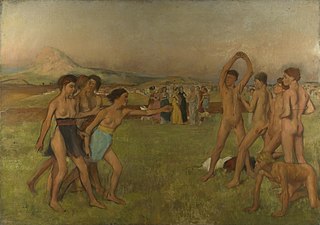 W
WYoung Spartans Exercising, also known as Young Spartans and also as Young Spartan Girls Challenging Boys, is an early oil on canvas painting by French impressionist artist Edgar Degas. The work depicts two groups of male and female Spartan youth exercising and challenging each other in some way. The work was purchased by the trustees of the Courtauld fund in 1924 and is now in the permanent collection of the National Gallery in London.